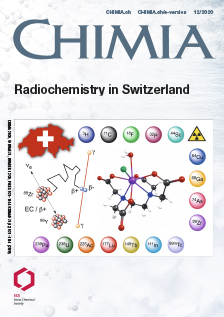Neuroimaging with Radiopharmaceuticals Targeting the Glutamatergic System
DOI:
https://doi.org/10.2533/chimia.2020.960PMID:
33357289Keywords:
Glutamate receptors, Glun2b subunit of the ionotropic nmda receptor, Metabotropic glutamate receptor subtype 5 (mglur5), Pet tracer evaluationAbstract
Radiopharmacy at ETH has worked on the development of novel PET tracers for neuro-, cardiac- and tumor imaging for many years. In this paper, our efforts on targeting the glutamatergic system of the metabotropic glutamate receptor subtype 5 (mGluR5) and the ionotropic N-methyl-D-aspartate (NMDA) receptor are summarized. We briefly described the principles of positron emission tomography (PET) tracer development for the central nervous system (CNS) and the radiolabeling methods used in our laboratory. To assess the radioligands, results of in vitro autoradiography, biodistribution, and metabolite studies as well as PET imaging data are discussed. Furthermore, key PET parameters for kinetic modeling and quantification methods are provided. Two mGluR5 PET tracers, [11C]ABP688 and [18F]PSS232, were translated in our GMP labs and evaluated in human subjects. The newly developed GluN2B PET tracer [11C]Me-NB1 is currently being investigated in a first-in-human PET study and several F-18 labeled tracers are being evaluated in non-human primates in which the first-in-class will be translated for human studies.Downloads
Published
2020-12-23
Issue
Section
Scientific Articles
License
Copyright (c) 2020 Linjing Mu, Stefanie D. Krämer, Hazem Ahmed, Stefan Gruber, Susanne Geistlich, Roger Schibli, Simon M. Ametamey

This work is licensed under a Creative Commons Attribution-NonCommercial 4.0 International License.
How to Cite
[1]
L. Mu, S. D. Krämer, H. Ahmed, S. Gruber, S. Geistlich, R. Schibli, S. M. Ametamey, Chimia 2020, 74, 960, DOI: 10.2533/chimia.2020.960.







